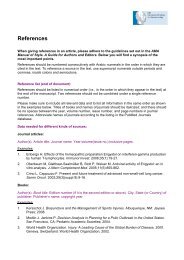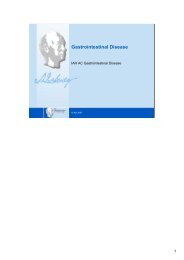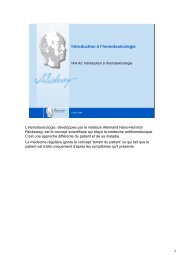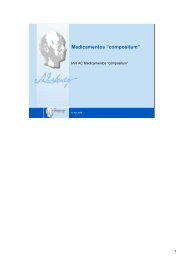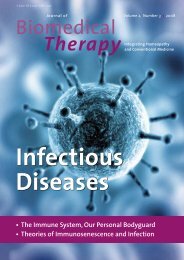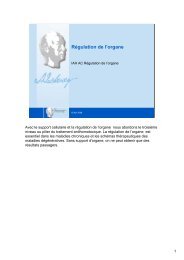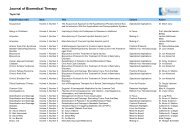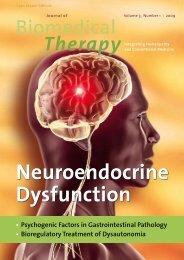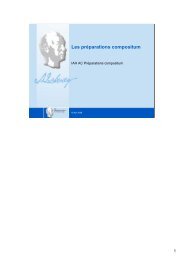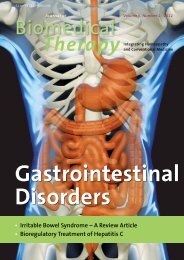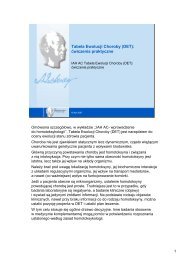Metabolic Syndrome - International Academy of Homotoxicology
Metabolic Syndrome - International Academy of Homotoxicology
Metabolic Syndrome - International Academy of Homotoxicology
You also want an ePaper? Increase the reach of your titles
YUMPU automatically turns print PDFs into web optimized ePapers that Google loves.
) What Else Is New?<br />
Educational aid or electronic babysitter?<br />
A recent US survey shows that<br />
parents let their infants and toddlers<br />
watch television on a regular basis.<br />
A happy partnership<br />
helps to<br />
prevent the<br />
development<br />
<strong>of</strong> CHD.<br />
Live hard,<br />
die young<br />
Mortality rates <strong>of</strong> rock and pop stars<br />
are significantly higher (more than<br />
1.7 times) than rates for their age<br />
peers in the general population. The<br />
average age <strong>of</strong> death for pop musicians<br />
is unusually low: 42 years in<br />
North America and only 32 years in<br />
Europe, according to the findings <strong>of</strong><br />
an epidemiological study. The most<br />
frequent causes <strong>of</strong> death are drugs<br />
(31%), cancer (20%), accidents<br />
(16%), and suicide (9%). In later life,<br />
when stars are no longer in the spotlight,<br />
their mortality rates begin to<br />
return to population levels. Even<br />
then, however, drug and alcohol<br />
abuse remain significant causes <strong>of</strong><br />
death. Of particular concern is the<br />
fact that rock stars are serving as<br />
poor role models for teens, who<br />
need to be encouraged not to imitate<br />
the lifestyles <strong>of</strong> their idols.<br />
J Epidemiol Community Health<br />
2007;61:896-901<br />
Marital discord is bad<br />
for the heart<br />
An unhappy marriage puts heart<br />
health at risk. A study followed<br />
9,011 British subjects for 12 years.<br />
Most <strong>of</strong> them (8,499) did not have<br />
heart disease when the study began.<br />
During the observation period, 589<br />
developed coronary heart disease. In<br />
analysis <strong>of</strong> the participants’ living<br />
situations, unhappy partnerships<br />
emerged as an independent risk factor.<br />
Arch Intern Med<br />
2007;167(18):1951-1957<br />
Love handles<br />
are hereditary<br />
For the first time, scientists have<br />
identified a specific gene on chromosome<br />
16 that is instrumental in<br />
increasing body mass index and is<br />
involved in the development <strong>of</strong> diabetes<br />
mellitus. This variant <strong>of</strong> the<br />
FTO (fat mass and obesity associated)<br />
gene is a reproducible variant in<br />
the first intron. The association with<br />
excess weight was found in several<br />
cohorts with a total <strong>of</strong> 38,759 participants.<br />
Individuals with a homozygous<br />
risk allele were 1.67 times<br />
more likely to become obese and averaged<br />
3 kg heavier. The connection<br />
is first observed around age six and<br />
is independent <strong>of</strong> gender and ethnicity.<br />
In the future, individuals predisposed<br />
to obesity will be able to<br />
take preventive measures early in<br />
life.<br />
Science 2007;316(5826):889-894<br />
FOR PROFESSIONAL USE ONLY<br />
The information contained in this journal is meant for pr<strong>of</strong>essional use only, is meant to convey general and/or specific worldwide scientific information relating to the<br />
products or ingredients referred to for informational purposes only, is not intended to be a recommendation with respect to the use <strong>of</strong> or benefits derived from the<br />
products and/or ingredients (which may be different depending on the regulatory environment in your country), and is not intended to diagnose any illness, nor is it<br />
intended to replace competent medical advice and practice. IAH or anyone connected to, or participating in this publication does not accept nor will it be liable<br />
for any medical or legal responsibility for the reliance upon or the misinterpretation or misuse <strong>of</strong> the scientific, informational and educational content <strong>of</strong> the<br />
articles in this journal.<br />
The purpose <strong>of</strong> the Journal <strong>of</strong> Biomedical Therapy is to share worldwide scientific information about successful protocols from orthodox and complementary practitioners.<br />
The intent <strong>of</strong> the scientific information contained in this journal is not to “dispense recipes” but to provide practitioners with “practice information” for a better<br />
understanding <strong>of</strong> the possibilities and limits <strong>of</strong> complementary and integrative therapies.<br />
Some <strong>of</strong> the products referred to in articles may not be available in all countries in which the journal is made available, with the formulation described in any article or<br />
available for sale with the conditions <strong>of</strong> use and/or claims indicated in the articles. It is the practitioner’s responsibility to use this information as applicable<br />
and in a manner that is permitted in his or her respective jurisdiction based on the applicable regulatory environment. We encourage our readers to share<br />
their complementary therapies, as the purpose <strong>of</strong> the Journal <strong>of</strong> Biomedical Therapy is to join together like-minded practitioners from around the globe.<br />
Written permission is required to reproduce any <strong>of</strong> the enclosed material. The articles contained herein are not independently verified for accuracy or truth. They have<br />
been provided to the Journal <strong>of</strong> Biomedical Therapy by the author and represent the thoughts, views and opinions <strong>of</strong> the article’s author.<br />
) 9<br />
Journal <strong>of</strong> Biomedical Therapy 2008 ) Vol. 2, No. 1



